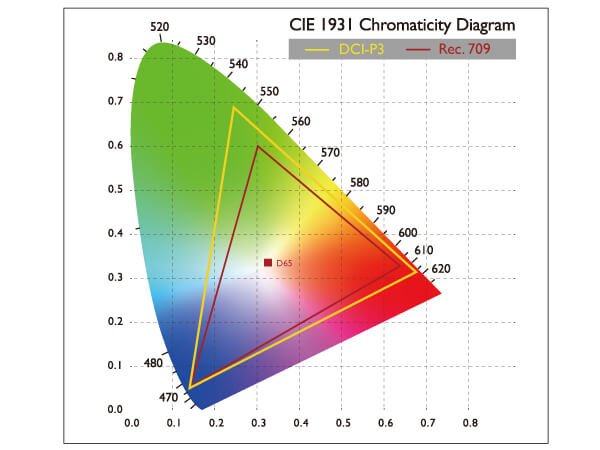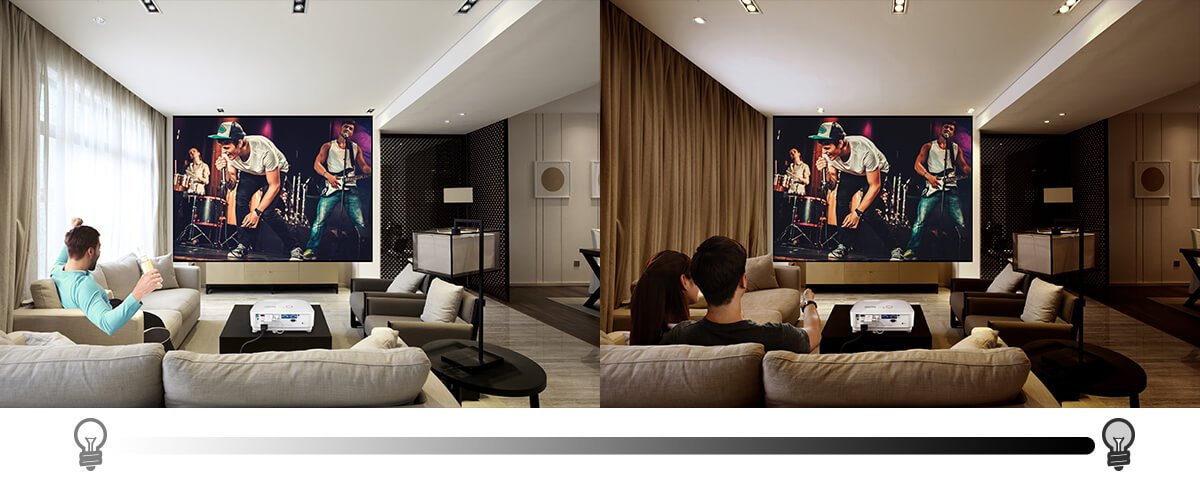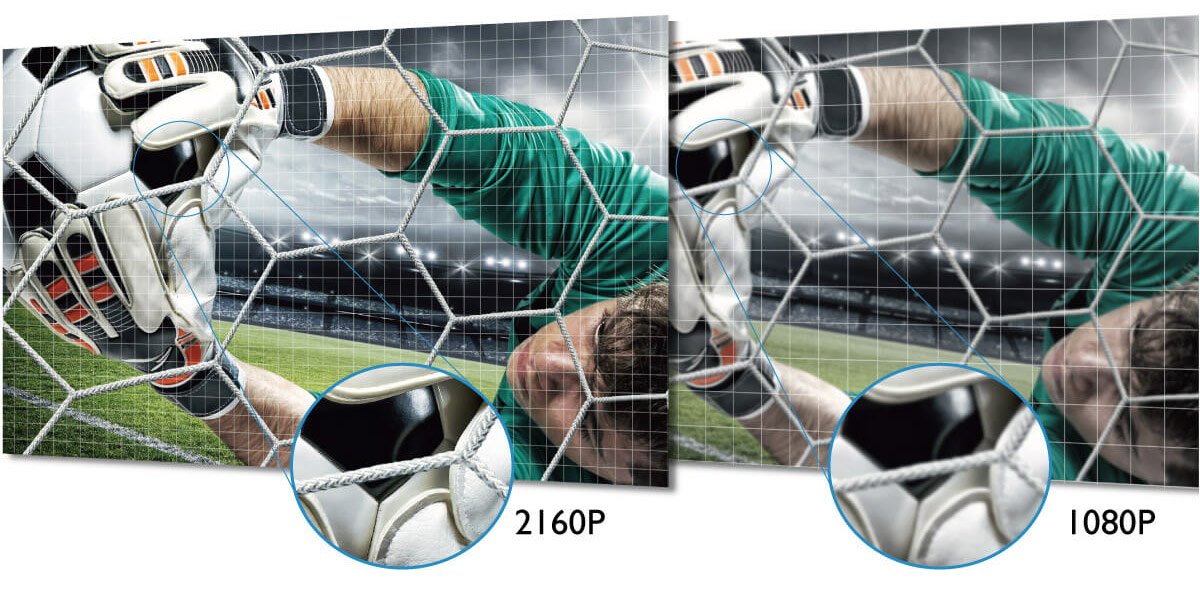Important keywords when choosing a projector


To help you on your quest for the ideal projector, we’ve put together this glossary to make sure you better understand many of the terms and concepts that are frequently encountered when shopping for projectors and their associated technologies. Get more confident and go out there equipped with the knowledge necessary to pick the right model, even if it’s your first projector ever.
Content Index
A-C: Aspect Ratio, Calibration, Color Gamut, Color Temperature, Color Wheel, Contrast
D-H: DCI-P3, DLP, DMD, Dynamic Iris, Frames per Second (FPS), Gamma, Ghosting, HDMI, HDR, HLG
I-O: Input Lag, Keystone, LCD, Lens Shift, Light Reflection, Lumen, Native Resolution, OSD
N-Z: Native Resolution, OSD, Rec. 709, RGB, Screendoor, Tab Tension, Throw Distance, Upscaling, Zoom
Aspect ratio
The size and shape of displayed images. Typical HD/UHD content is 16:9 wide screen, while movie theaters use 2.35:1. Older “letterbox” content from before HD was 4:3.
Calibration
The professional adjustment of a projector or display to accepted standards such as Adobe RGB, DCI-P3, Rec. 709, and Rec. 2020. If a projector offers good calibration the image you get on your screen stays very close to the source material, or to the way film makers and TV producers wanted the work to be viewed by audiences. In other words, accurate color means faithful reproduction of content. A poorly calibrated projector may depict a red car as orange, as an extreme example. You certainly don’t want that.
Color temperature
Since color is effectively energetic light, temperature determines what we see. Temperatures measured in kelvins, with almost all content in the 4000-7000K range. You may encounter the term “D65”. That refers to the temperature of light during daytime and serves as a reference in many color spaces, including Rec. 709. D65 measures approximately 6500 kelvins.
Color gamut
The range and depth of color displayed. Different devices have varying color capabilities, essentially the number of colors they can show (even if the human eye and brain can’t perceive them). Examples include DCI-P3, Rec. 709, and Rec 2020.
Color wheel
Component responsible for generating color in projectors. Basic color wheels have just three segments: red, green, and blue. Having multiple segments of each primary color helps produce richer colors and wider a wider color gamut, so good projectors have RGBRGB color wheels (two segments per primary color). Variations exist, such as RGBW (adds a white-dedicated segment) and RGBCWY (red, green, blue, cyan, white, yellow). Color wheels with high primary color purity offer the best color performance.


Contrast
The difference between white and dark. Higher contrast helps create more dramatic, impactful images. Contrast ratios describe the amount of white per unit of black, for example 30,000:1.
DCI-P3
DCI-P3 is a specialized color gamut developed for digital movie projection in professional cinemas and is wider than Rec. 709, especially in green and red spaces, that is to say DCI-P3 produces more nuanced greens and reds, while blues generally equal what you get with Rec. 709.


DLP
Digital light processing, a technology that uses millions of micromirrors to generate a precise image sent by a powerful light source. Compared to other projection technologies like LCD, DLP mechanisms resist dust build up and don’t require complex filters that end up degrading image quality. Most importantly, the mirrors used in DLP are extremely long-lasting, while LCD panels deteriorate much more quickly. Even if the light source (lamp) requires replacement, image quality remains at peak with DLP, while with LCD quality worsens over time regardless of how new the lamp may be.
Learn more: What’s BenQ DLP Technology?
DMD
Digital micromirror device, a precision-crafted component that has millions of tiny mirrors working together with a processor to allow projection of images in resolutions up to true 4K.
Dynamic iris
A very useful and advantageous mechanism in select projectors that’s integrated between the projector lamp and lens which opens and closes depending on the overall brightness of the projected image to adjust light output. Used to fine-tune the projected image by letting the projector enhance contrast performance, resulting in accurate dark scenes and optimized bright areas, thus preventing the loss of image detail.
Learn more: How does a dynamic iris works?
Frames per second (FPS)
The number of times a display refreshes per second. The more frames, the smoother video appears. TV and movie content usually uses 24 frames, video games typically run at 30 or 60, but increasingly go up to 144. Often measured in Hertz (Hz).
Gamma
The way voltage affects brightness. Increasing voltage boosts light output and therefore means a brighter image.
Ghosting
When a source and a display aren’t properly synced, images can appear to have “duplicates” since the source tries to update too fast for the display.
HDMI
High Definition Multimedia Interface, the most common home media connector and cable standard since the mid 2000’s. HDMI 2.0 and up required for 4K UHD at 60fps.
HDR
High dynamic range. Allows brighter whites and deeper blacks for a more realistic and dramatic image.
Learn more: High resolution is not HDR. Contrast is the key!
Learn more: What's BenQ HDR-PRO technology?
HLG
Hybrid Log-Gamma (HLG) is a version of HDR that was jointly developed by NHK and the BBC. Unlike other forms of HDR, HLG does not use metadata, which means it is compatible with both SDR and HDR displays.
Input lag
The delay between an image being sent out by a projector and the same image getting displayed on screen. In the context of gaming, also includes the additional delay between the screen and the controller (also known as controller latency). Measured in milliseconds, input lag of over 40ms makes video games essentially unplayable and may cause lip sync issues when watching movies and TV.
Keystone
When a projector isn’t properly aligned in front of a screen, the image stops being rectangular and loses its aspect ratio. Fixed by (automatic) keystone correction on select projectors.
LCD
Liquid crystal display, one of the leading technologies in TVs and projectors. Different from digital light processing (DLP) in that LCD panels tend to fade and change properties over time, while DLP mirrors retain their initial quality much longer and do not suffer from LCD-typical issues such as hot spotting and image uniformity problems.
Lens shift
Provides flexibility for either installing or placing the projector. The image can be shifted up, down, left, and right within a certain range without moving the projector itself.
Light reflection
Important aspect of projector screens. The more light a material reflects, the better it is for use with projectors. Light rejection technologies increase the amount of light that reaches viewers.
Lumen
Popular unit for measuring total light output and brightness. Luminosity matters for the way a projector behaves based on ambient light conditions, for example bright and dark rooms.


Native resolution
The “true”, hardware-determined resolution of a display source. Currently, common resolutions include full HD (1920 x 1080) or 1080p and ultra HD (3840 x 2160) or 2160p, the “p” standing for progressive scan. Measured in pixels along two axes, or in megapixels per frame.


OSD
On screen display. The user interface that shows up on a display when prompted by a remote control or buttons on the display itself. Ideally very minimal and intuitive.
Projector offset
Projector offset indicates the distance from the projector’s lens assuming a direct line to the top edge of the screen. In other words, the percentage of the screen height that will be projected above the projection lens optical axis.
Lens offset = (Screen height + Offset height ) / Screen height
Rec. 709
Rec. 709 color gamut enables a projector to deliver colors so real that they reflect what the human eye perceives. One of the most common color spaces for content presented in full HD or higher resolutions.
RGB
Red, green, and blue – the three components of all color displays.
Learn more: What is an RGBRGB color wheel?
Screendoor
An effect caused by devices that struggle to fill up pixels, or generate an image, fast enough. Results in a grid-like anomaly that resembles a screen door, hence the name.
Tab tension
Projector screen design that uses tension to keep a screen flat, which is better for image quality.
Throw distance
Distance a projector needs to show an image on a screen of a given size. Differs between fixed and zoomable projectors.
Upscaling
Processing of an image to increase its resolution. For example, most 4K TVs and projectors can upscale 1080p content to 2160p, but the process may cause image compromise.
Zoom
Very useful projector feature, allows maintaining image size from different throw distances. Fixed lens projectors that can’t zoom have to be physically moved when changing screen sizes, a very cumbersome process.